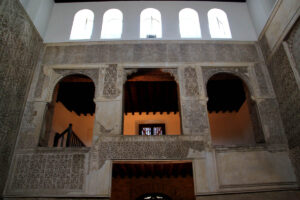Jewish Literatures Places and Heritage 21 novembre 2024
The European Association for Jewish Studies is delighted to invite its members to join the first iteration of a new format, an annual conference with panels and plenary sessions revolving around a broader theme. This year, EAJS Virtual will be hosted by Ayn–T, Cultural Association for the Study of Jewish–German Culture, Rome and organised by Prof. Roberta Ascarelli, Prof. Myriam Silvera, Prof. Carsten Wilke, and Federico Bossone, and will explore the interplay among Jewish literatures places and heritage. The conference will be held in English.
Since the mid–90s, the promotion of Jewish heritage sites has had a significant impact on the representation of cultural landscapes, as well as on their economy. “Synagogues, Jewish museums, ghetto areas and Jewish cemeteries, Shoah memorials” (Gruber 2002, 134) now belong to the must–see attractions of European cities and regions. At the same time, an elite interest in sites linked to literary creativity has entered the itineraries and travel experiences of mainstream culture. The search for settings that have produced literary imagination or are depicted in literature created a new and secular form of pilgrimage. Centres of religious or historical value have become entwined with places found in novels, travel notes, and diaries (Cusak and Norman 2015). The intersecting dynamics of reading and traveling promises to get deeper into the Jewish past.
Prague, Córdoba, Troyes, Vienna…
In Prague, ranked among the top 30 most visited cities globally, Rabbi Loew, also known as the Maharal of Prague, holds a significant place within the city as well as in the history of Jewish thought. The city is also deeply intertwined with its most renowned Jewish author, Franz Kafka, whose presence echoes throughout the city’s cultural landscape. With a lesser intensity, other cities have chosen Jewish literary hosts for their international image. Statues and other references in the public space, if not entire museums, showcase Moses Maimonides in Córdoba, Rashi in Troyes, Sigmund Freud in Vienna, the Gaon Elijah in Vilnius, Bruno Schulz in Drohobych, Elie Wiesel in Sighetu Marmației in Romania, among many others.
Even before the spatial turn found its way into numerous academic disciplines, the investigation of spaces such as urban environments, landscapes, figurative spaces in literature has always been captivating (Hallet and Neumann 2009). However, the perceived strong bond between Jewish literature and spaces and places is not as evident as for mainstream society and non–Jewish literature. On the one hand, the link between Jewish authors or the places in their writings seem to be of a random nature due to the diaspora, which is seen as part of the Jewish condition (Czendze and Francisco 2018, 146). On the other hand, the devastations of the 20th century destroying numerous centres of Jewish life – including the Eastern European shtetl described in Jewish novels of the 19th and 20th centuries – make the recourse to literary sources all the more plausible.
We foresee keynotes during plenary sessions, separate thematic panels, as well a round table discussion projected towards future research that will be the concluding event.
Fields and Theme’s to explore
The conference seeks to provide scholars with the opportunity to collaborate, generate fresh ideas for future research inquiries, and share field experiences and projects. Scholars are encouraged to explore within their own disciplines and across others, fostering new connections to rethink approaches to Jewish Literature within Jewish Studies.
• Studies on Jewish Literary Geographies and Jewish Studies
• Theoretical Issues and Case Studies: How could the link between Literature, Heritage, and Tourism impact the cultural diffusion (Within and beyond the prominent cases mentioned above).
• Narration and Representation of Jewish Spaces and Cultural Change.
• Studies on Literary Geographies and their connection to Jewish Cultural Heritage and to Jewish history.
• Literature and the Performance of Void Spaces.
• Experiences and Work on the Field in Jewish (Literary) Tourism
• Presentations on collaborative research initiatives, bridging Academic Scholarship with Local Heritage.
• Theoretical Issues and Case Studies: How could the link between Literature, Heritage, and Tourism impact the cultural diffusion (Within and beyond the prominent cases mentioned above).
• Narration and Representation of Jewish Spaces and Cultural Change.
• Studies on Literary Geographies and their connection to Jewish Cultural Heritage and to Jewish history.
• Literature and the Performance of Void Spaces.
• Experiences and Work on the Field in Jewish (Literary) Tourism
• Presentations on collaborative research initiatives, bridging Academic Scholarship with Local Heritage.
Panel and Paper Proposals
Proposals should be sent to eajsvirtual2024@gmail.com no later than July 11, 2024, and include paper title, abstract in English (max. 250 words), name, e–mail address, institutional affiliation, and a brief bio (max. 100 words). The submission of complete panel proposals is welcome and should include a brief description (max. 250 words), including 3–4 presentations. Additionally, please provide a short bio for each speaker (max. 150 words).
Biblography re Jewish Literature Places and Heritage
- Cusack, Carole M; Norman, Alex. 2015. Religion, Pilgrimage, and Tourism: Secular Pilgrimage and Spiritual Tourism. Abingdon: Routledge.
- Czendze, Oskar; Francisco Jason. 2018. “Old Homes Made New: American Jews travelling to Eastern Europe from 1920 to the Present”. In Memory, Migration and Travel edited by Sabine Marschall. Oxon and New York: Routledge.
- Gruber, Ruth Ellen. 2002. Virtually Jewish. Reinventing Jewish Culture in Europe. Berkeley and Los Angeles: California University Press.
- Hallet, Wolfgang; Neumann, Birgit. 2009. “Raum und Bewegung in der Literatur: Zur Einführung“. In Raum und Bewegung in der Literatur. Die Literaturwissenschaften und der Spatial Turn, edited by Wolfgang Hallet and Birgit Neumann. Bielefeld: transcript Verlag
Notes on Jewish Literatures Places and Heritage
- Download here a PDF of the above Call for Papers.
- You may want to visit the website of the European Association for Jewish Studies
